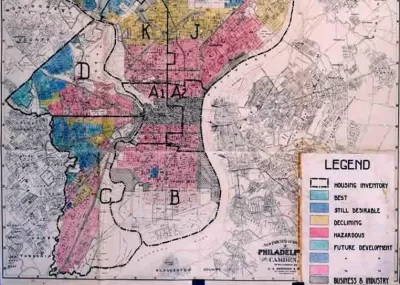New Deal agencies did engage in discriminatory lending practices–but not quite in the way we think.

Redlining–the practice of denying mortgages in certain neighborhoods based on maps created by the Home Owners Loan Corporation (HOLC) in the 1930s–has long been associated with disinvestment in Black neighborhoods. But according to Jake Blumgart, new research "complicates our understanding" of the practice and shows that redlining "did not quite work in the way that it is popularly understood."
In the 1930s, HOLC "drew up color-coded maps that evaluated neighborhoods based on their presumed prospects, with those believed to have the worst outlooks drawn in red." Until now, historians have interpreted this as a root cause of discriminatory lending. "But new research shows that the maps very probably did not guide private lenders or the Federal Housing Administration (FHA), which clearly engaged in racist lending practices all on their own. The HOLC, however, actually loaned widely in Black neighborhoods and other red-shaded areas."
As Blumgart writes, "Fishback and his co-authors are not arguing that racist mortgage practices did not occur. But they are trying to disentangle the policy of the two New Deal-era mortgage institutions, one of which engaged in heavily anti-Black practices (the FHA) and the other of which did not (HOLC)." Based on a sample of 16,000 loans in three cities, the researchers "found that in all three cities the HOLC refinanced many loans in neighborhoods coded red, with no evidence of discrimination against Black homeowners. The FHA, on the other hand, did not insure mortgages in the neighborhoods where Black homeowners lived and chiefly targeted newly constructed homes, which almost exclusively catered to whites, and those in wealthier neighborhoods."
This yields important lessons for today's policymakers, who can shape an agency's practices through the language of their legislation. "[T]he FHA was created to encourage 'economically sound”' loans that mostly translated into new construction — especially in the suburbs — which at that time almost entirely went to white families." Meanwhile, HOLC's legislation "is written to center struggling homeowners and to bail them out of a macroeconomic crisis they did not create," leading to different practices from the two agencies.
Amy Hillier, a researcher whose work showed that HOLC did, in fact, lend "heavily" in "redlined" areas, concludes that the new research validates her findings. "[H]ousing discrimination can happen in very subtle ways that are at least as insidious as very dramatic red maps with lines on them."
FULL STORY: Redlining Didn’t Happen Quite the Way We Thought It Did

Planetizen Federal Action Tracker
A weekly monitor of how Trump’s orders and actions are impacting planners and planning in America.

Maui's Vacation Rental Debate Turns Ugly
Verbal attacks, misinformation campaigns and fistfights plague a high-stakes debate to convert thousands of vacation rentals into long-term housing.

Restaurant Patios Were a Pandemic Win — Why Were They so Hard to Keep?
Social distancing requirements and changes in travel patterns prompted cities to pilot new uses for street and sidewalk space. Then it got complicated.

In California Battle of Housing vs. Environment, Housing Just Won
A new state law significantly limits the power of CEQA, an environmental review law that served as a powerful tool for blocking new development.

Boulder Eliminates Parking Minimums Citywide
Officials estimate the cost of building a single underground parking space at up to $100,000.

Orange County, Florida Adopts Largest US “Sprawl Repair” Code
The ‘Orange Code’ seeks to rectify decades of sprawl-inducing, car-oriented development.
Urban Design for Planners 1: Software Tools
This six-course series explores essential urban design concepts using open source software and equips planners with the tools they need to participate fully in the urban design process.
Planning for Universal Design
Learn the tools for implementing Universal Design in planning regulations.
Heyer Gruel & Associates PA
JM Goldson LLC
Custer County Colorado
City of Camden Redevelopment Agency
City of Astoria
Transportation Research & Education Center (TREC) at Portland State University
Jefferson Parish Government
Camden Redevelopment Agency
City of Claremont





























